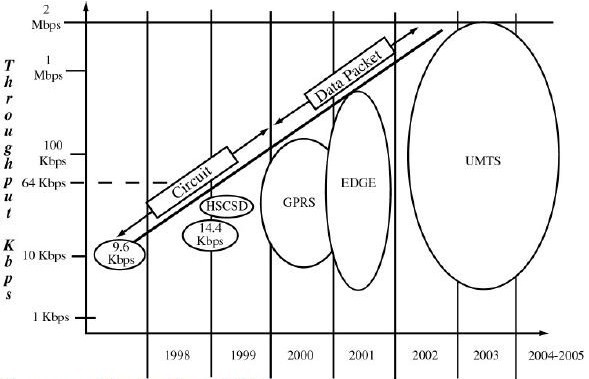Low-Earth-Orbits
Private companies are striving to provide truly seamless global communications to the public, making today’s personal communication systems (PCS) a proving ground for new technologies. This global approach has sparked the development of several new communication satellite systems, which abandon the traditional use of geostationary earth orbit (GEO) in favor of medium earth orbit (MEO) and low earth orbit (LEO) satellite systems. LEO and MEO satellite networks increase the service regions of their designers, providing services to regions of the world where there is little or no telecommunication infrastructure, such as Asia, Africa, Eastern Europe, South America, and the polar regions. These LEO and MEO satellite networks provide global coverage to their users, which a typical GEO satellite system cannot provide. One such LEO satellite system, Motorola’s IRIDIUM system, was completely deployed in May 1998.
In December 1990, Motorola filed an application with the FCC for the purposes of constructing, launching, and operating a LEO global mobile satellite system known as Iridium. This was the hot button that sparked the world into a frenzy. Iridium was a concept of launching a series of 66 satellites around the world to provide global coverage for a mobile communications service operating in the 1.610 to 1.6265 GHz frequency bands. The concept was to use a portable or mobile transceiver with low profile antennas to reach a constellation of 66 satellites. Each of the satellites would be interconnected to one another through a radio communications system as they traversed the globe at 413 nautical miles above the earth in multiple polar orbits.This would provid worldwide coverage, much similar to an orange slice concept . This would provide a continuous line−of−sight coverage area from any point on the globe to virtually any other point on the globe, using a spot beam from the radio communications services on−board each of the satellites.
The main component s of the IRIDIUM system are the satellites, gateways, and user handsets. The satellites utilize inter-satellite links (ISLs) to route network traffic. Regional gateways will handle call setup procedures and interface IRIDIUM with the existing public switched telephone network (PSTN). A dual-mode handset will allow users to access either a compatible cellular telephone network or IRIDIUM. IRIDIUM will give the user the capability to receive persona l communications worldwide using a single telephone number. It is designed to augment the existing terrestrial and cellular telephone networks. IRIDIUM is expected to provide cellular-like service in areas where terrestrial cellular service is unavailable, or where the PSTN is not well developed.
Network Connectivity
Communication networks are commonly represented by graphs of nodes, which represent communication locations,and links,which represent communication transmission paths. The IRIDIUM network essentially has two planes of nodes, the satellites and the earth stations, which are moving with respect to each other. As a result, the links connecting earth stations to satellites change over time.
In the IRIDIUM network, a link is established from an earth station to the satellite with the strongest signal. The satellites are moving much faster than the mobile users. Mobile user scan be considered stationary with respect to the velocity of the satellites, as even a mobile user in an airplane is travelling much slower than a satellite. As the satellites pass overhead, the link from earth station to satellite is handed off from a satellite leaving the user’s area to one entering the user’s area.
System Capacity
The IRIDIUM system uses a combination of time division multiple access ( TDMA) and frequency division multiple access (FDMA). The TDMA frame is 90 ms long and it contains four full-duplex user channels at a burst data rate of 50 kb/s.The four full-duplex channels consist of four uplink time slots and four downlink time slots. The IRIDIUM system will support full-duplex voice channels at 4800 b/s and half-duplex data channels at 2400 b/s. The specific details of the TDMA frame, such as the number of framing bi ts and the length of a user time slot, are not published in open literature. In addition, the type of voice encoding that will be used to provide acceptable voice quality at 2400 b/s is proprietary and is not published in open literature.
Call Processing
The IRIDIUM system will allow users to roam worldwide and still utilize a single subscriber number. To accomplish this, each user will have a home gateway that normally provides his service. The gateways in this system will be regional and will support large geographical areas. An IRIDIUM subscriber is uniquely identified by three numbers: the mobile subscriber integrated services digital network number (MSISDN), the temporary mobile subscriber identification (TMSI), and the IRIDIUM mobile subscriberidentity (IMSI).
The MSISDN is the telephone number of an IRIDIUM subscriber. The MSISDN is five digits long, and makes up part of the twelve-digit number dialed to reach a subscriber. The first field of the twelve-digit number is the four-digit country codeThe second field of the number is a three-digit geographical code. This code will be used to identify a user’s home country in regions where one gateway services mor e than one country. The third and final field of the number is the MSISDN. The TMSI is a temporary number that is transmitted over the network during call setup. This number is changed periodically to protect subscriber confidentiality.
Watch this video for more information.
http://www.deetc.isel.ipl.pt/sistemastele/ST1/arquivo/IRIDIUM%203.pdf
Broadband Telecommunications Handbook (VPN 3GW GPRS MPLS VoIP SIP).pdf


























